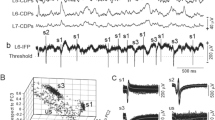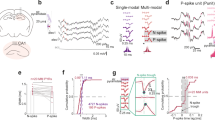Summary
Depth profiles of averaged evoked potentials (AEPs) and simultaneously generated unitary activity have been recorded from the cuneate nucleus of the rat in response to controlled tactile stimulation of the ipsilateral forepaw.
Four separate components of the AEPs were isolated, N1, N2, P, and N3. N1corresponds to the classical N wave previously described by other workers; four fractions of N1 are described. The classical P wave which follows N1 reverses at 150–350 μm depth to become a negative wave of identical time course, the N2 wave, at deeper locations. N2 peaks deeper than N1 within the non-relay portion of the cuneate nucleus, or below in the subnuclear reticular førmation where it is the only significant evoked component. Its strong susceptibility to high Mg++ C.S.F. superperfusion suggests a polysynaptic origin. It is argued that the depth distribution and time course of N2 does not support its function relating to depolarisation of primary afferents (PAD) in the vicinity of synaptically driven cuneate cells. Alternative possibilities for its origin are discussed.
An additional sustained component of the AEP, the N3 component, is described and evaluated. N3 is co-extensive with N1, has a long time course and simple exponential decay, and is the component most resistant to high Mg++ C.S.F. superperfusion. A similar component to N3 has been described by previous workers in the spinal cord, where it has been shown to arise from glia depolarised by K+ effluxing from discharging afferents and cells. A similar origin for N3 is suggested, and its possible involvement with PAD discussed.
Similar content being viewed by others
References
Amassian VE, de Vito JL (1957) La transmission dans le noyeau Burdach (nucleus cuneatus). Colloq Int Cent Nat Rech Sci (Paris) 67: 353–393
Andersen P, Eccles JC, Schmidt RF, Yokota T (1964a) Slow potential waves produced in the cuneate nucleus by cutaneous volleys and by cortical stimulation. J Neurophysiol 27: 78–91
Andersen P, Eccles JC, Schmidt RF, Yokota T (1964b) Depolarization of presynaptic fibers in the cuneate nucleus. J Neurophysiol 27: 92–106
Andersen P, Eccles JC, Schmidt RF, Yokota T (1964c) Identification of relay cells and interneurones in the cuneate nucleus. J Neurophysiol 27: 1080–1095
Andersen P, Eccles JC, Oshima T, Schmidt RF (1964d) Mechanisms of synaptic transmission in the cuneate nucleus. J Neurophysiol 27: 1096–1116
Andres-Trelles F, Cowan CM, Simmonds MA (1976) The negative potential wave evoked in the cuneate nucleus by stimulation of afferent pathways: Its origin and susceptibility to inhibition. J Physiol (Lond) 258: 173–186
Armstrong-James MA, Ewart WR (1978) The depth profile of the P wave in the cuneate nucleus. J Physiol (Lond) [Proceedings] 284: 79
Barron DH, Matthews BAC (1938) The interpretation of potential changes in the spinal cord. J Physiol (Lond) 85: 73–103
Borland RG, Matthews BHC, Nicholson AN (1970) Spinal cord and root potentials. J Physiol (Lond) 210: 166P
Burke W, Sefton AJ (1966) Inhibitory mechanisms in lateral geniculate nucleus of rat. J Physiol (Lond) 187: 231–246
Cesa Bianchi MG, Mancia M, Sotgiu ML (1968) Depolarisation of afferent fibres to the Goll and Burdach nuclei, induced by stimulation of the brain-stem. Exp Brain Res 5: 1–15
Hámori J, Pasik T, Pasik P, Szentágothai J (1974) Triadic synaptic arrangements and their possible significance in the lateral geniculate nucleus of the monkey. Brain Res 80: 379–393
Jabbur SJ, Banna NR (1968) Presynaptic inhibition of cuneate transmission by widespread cutaneous inputs. Brain Res 10: 273–276
Jabbur SJ, Banna NR (1970) Widespread cutaneous inhibition in D.C.N. J Neurophysiol 33: 616–624
Kostyuk PG, Skibo GG (1968) Synaptic transmission of proprioceptive and cutaneous impulses through the cuneate nucleus. Fiziol Zh SSSR Imeni I M Sechenova 54: 649–658
Křiž N, Syková E, Ujec E, Vyklický L (1974) Changes of extracellular potassium concentration induced by neuronal activity in the spinal cord of the cat. J Physiol (Lond) 238: 1–16
Křiž N, Syková E, Vyklicky L (1975) Extracellular potassium charges in the spinal cord of the cat and their relation to slow potentials, active transport, and impulse transmission. J Physiol (Lond) 249: 167–182
Krnjevic K, Morris ME (1972) Extracellular K+ activity and slow potential changes in spinal cord and medulla. Can J Physiol Pharmacol 50: 1214–1217
Kruger LR (1973) The dorsal column system of the spinal cord: An updated review. UCLA: Brain Information Service
Kuypers HGJM, Tuerk JD (1964) The distribution of the cortical fibres within the nuclei cuneatus and gracilis in the cat. J Anat 98: 143–162
Lieberman AR (1973) Neurons with presynaptic perikarya and presynaptic dendrites in the rat lateral geniculate nucleus. Brain Res 59: 35–59
Lothman EW, Somjen GG (1975) Extracellular potassium activity, intracellular and extracellular potential responses in the spinal cord. J Physiol (Lond) 252: 115–136
Macleod NK, Lowe GA (1976) Field potentials in the olfactory bulb of the rainbow trout (Salmo gairdneri): Evidence of a dendrodendritic inhibitory pathway. Exp Brain Res 25: 255–266
Magni F, Melzack R, Moruzzi G, Smith CJ (1959) Direct pyramidal influences on the dorsal column nuclei. Arch Ital Biol 97: 357–377
Millar J, Basbaum AI (1975) Topography of the projection of the body surface of the cat to cuneate and gracile nuclei. Exp Neurol 49: 281–290
Odulata AB (1977) Patterns and fields of dorsal column fiber terminals in the cuneo-gracile nuclei of the rat. Exp Neurol 57: 112–120
Rall W, Shepherd GM, Reese TS, Brightman MW (1966) Dendrodendritic synaptic pathway for inhibition in the olfactory bulb. Exp Neurol 14: 44–56
Rustioni A, Sotelo C (1974) Synaptic organization of the nucleus gracilis of the cat. Experimental identification of dorsal root fibers and cortical afferents. J Comp Neurol 155: 441–468
Singer W, Lux HD (1973) Presynaptic depolarisation and extracellularpotassium in the cat lateral geniculate nuclei. Brain Res 64: 17–33
Somjen GS, Lothman EW (1974) Potassium, sustained focal potential shifts, and dorsal root potentials of the mammalian spinal cord. Brain Res 69: 153–157
Sotgiu ML, Morgnelli M (1976) Electrophysiological identification of pontomedullary reticular neurons directly projecting into dorsal column nuclei. Brain Res 103: 443–453
Therman PO (1941) Transmission of impulses through the Burdach nucleus. J Neurophysiol 4: 153–166
Tomasulo KC, Emmers R (1972) Activation of neurons in the gracile nucleus by two afferent pathways in the rat. Exp Neurol 36: 197–205
Valverde F (1965) The posterior column nuclei and adjacent structures in rodents: a correlated study by the Golgi method and electron microscopy. Anat Rec 151: 496
Vyklický L, Syková E, Křiž N, Ujec E (1972) Post-stimulation changes of extracellular potassium concentration in the spinal cord of the rat. Brain Res 45: 612–616
Walberg F (1965) Axo-axonic contacts in the cuneate nucleus, probable basis for presynaptic depolarization. Exp Neurol 13: 218–231
Wall PD (1958) Excitability changes in afferent fibre terminations and their relation to slow potentials. J Physiol (Lond) 142: 1–21
Author information
Authors and Affiliations
Rights and permissions
About this article
Cite this article
Armstrong-James, M., Ewart, W.R. Slow waves and unitary activity evoked by cutaneous stimulation from the rat cuneate nucleus. Exp Brain Res 39, 327–340 (1980). https://doi.org/10.1007/BF00237122
Received:
Issue Date:
DOI: https://doi.org/10.1007/BF00237122




